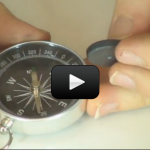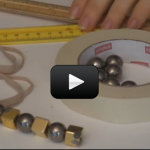What IS magnetism, anyway? You can feel how two north sides of a magnet push against each other, but what IS that invisible force, and why is it there? And how come magnets stick to the fridge and not a soda can? We’ll about to dive deep into the mysterious world of magnetism. Although scientists are still trying to puzzle out some of its secrets, I’m going to get you up to speed on what they do know today. Are you ready?
Why do magnets stick together? And why does breaking one in half create a new set of poles? We're going to explore these and other weird things about magnets. Are you ready? This video will get you started on the right foot for your study into with oddball world of magnets as you detected the earth's magnetic pulse, discover magnetic levitation, uncover weird eddy currents that counteract gravity, and discover how a grape is magnetic. Let's get started:
Why do magnets stick together? And why does breaking one in half create a new set of poles? We're going to explore these and other weird things about magnets. Are you ready? This video will get you started on the right foot for your study into with oddball world of magnets as you detected the earth's magnetic pulse, discover magnetic levitation, uncover weird eddy currents that counteract gravity, and discover how a grape is magnetic. Let's get started:
You can get started by watching this video, and afterward either read more about it or start your experiments!
Scientific Concepts:
- Magnetic fields are created by electrons moving in the same direction.
- Electrons can have a “left” or “right” spin.
- If an atom has more electrons spinning in one direction than in the other, that atom has a magnetic field.
- If an object is filled with atoms that have an abundance of electrons spinning in the same direction, and if those atoms are lined up in the same direction, that object will have a magnetic force.
- There’s still a lot about fields that is unknown. Fields are an exciting area of physics where a lot is still left to be discovered.
- A field is an area around a electrical, magnetic or gravitational source that will create a force on another electrical, magnetic or gravitational source that comes within the reach of the field.
- In fields, the closer something gets to the source of the field, the stronger the force of the field gets. This is called the inverse square law.
- A magnetic field must come from a north pole of a magnet and go to a south pole of a magnet (or atoms that have turned to the magnetic field.)
- All magnets have two poles. Magnets are called dipolar which means they have two poles.
- The two poles of a magnet are called north and south poles.
- The magnetic field comes from a north pole and goes to a south pole.
- Opposite poles will attract one another. Like poles will repel one another.
- Iron and a few other types of atoms will turn to align themselves with the magnetic field.
- The Earth has a huge magnetic field.
- The Earth has a weak magnetic force.
- The magnetic field probably comes from the moving electrons in the currents of the Earth’s molten core.
- The Earth has a north and a south magnetic pole which is different from the geographic north and south pole.
- Compasses turn with the force of the magnetic field.
- Over time iron atoms will align themselves with the force of the magnetic field.












